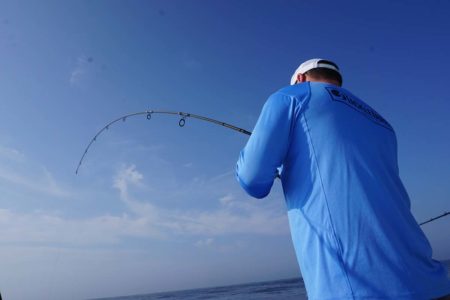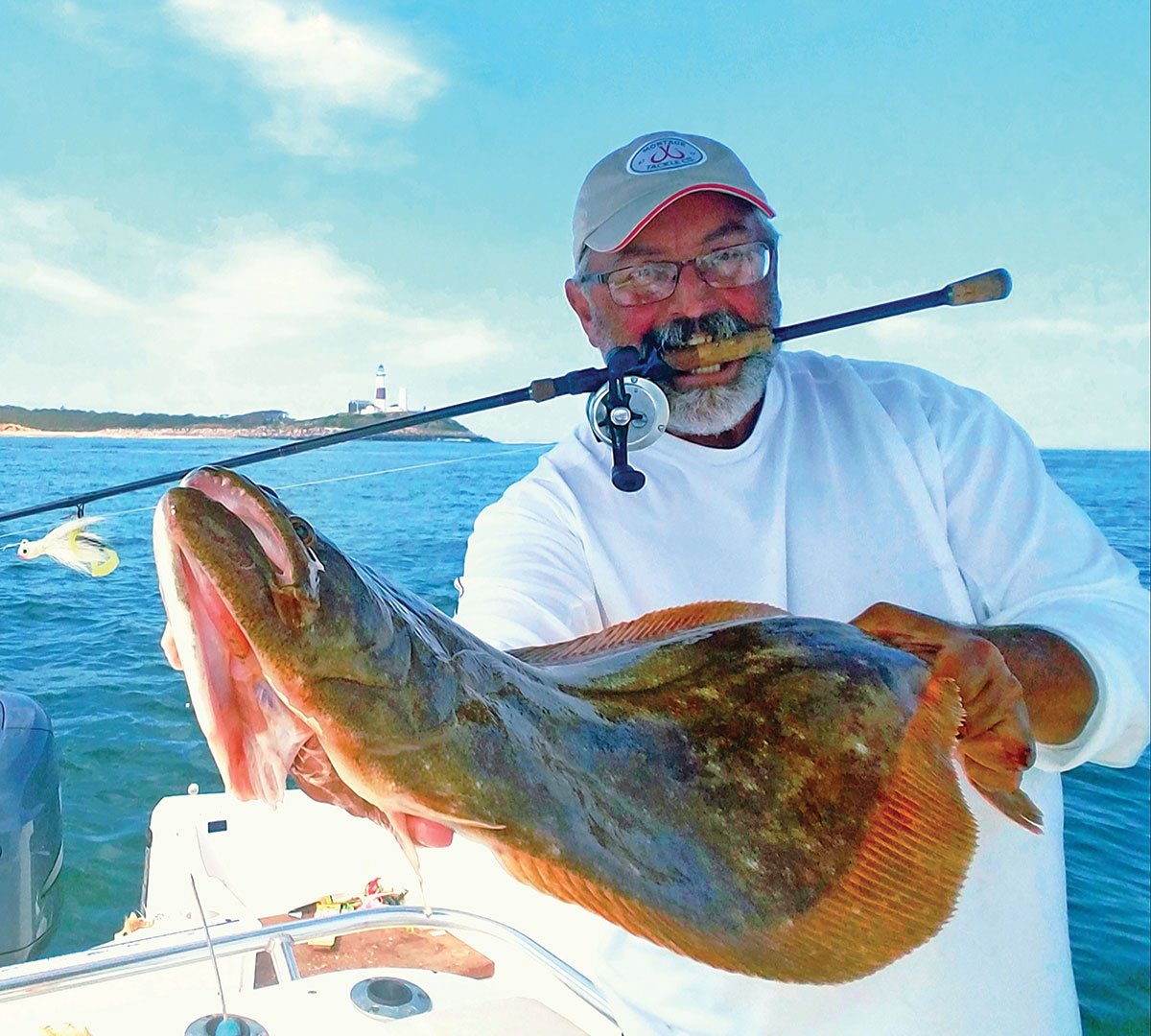
Focusing your efforts in the ocean during August and September can make that dream of a double digit doormat a reality.
Late summer has long been prime time for big fluke in ocean waters stretching from New Jersey to Cape Cod. Quotas placed on the dragger fleet have helped this fishery to rebound in many areas, and the August to September time period is once again an opportune time to score that double digit doormat you’ve dreamed about. It has also resulted in good numbers of quality fish in the 5- to 10-pound class for the sharpies and anglers in the know.
By late August, fluke that have been staying out in the deep water begin to concentrate along the inshore waters from 40 to 100 feet deep. Their main goal is to fill their bellies with the myriad baitfish available before gradually moving offshore where they will eventually settle beyond the 70 Fathom Curve out to the Continental Shelf. During their migration trek to the warmer deeper waters, most of the fish will make a few stopovers at the nearest oasis to fill their bellies for the impending journey. During the months of August and September, those pit stops include all the artificial reefs, wrecks and rocky bottoms that hold an abundance of sea life.
Prime Structure
Artificial reefs and wrecks are easiest to target and great producers of quality fluke. Artificial reefs in the Northeast are man-made using a large variety of objects such as cars, aircraft, demolition spoil, military tanks and concrete reef balls. What they all have in common is they provide hard surface areas to which algae and invertebrates, such as barnacles and crustaceans, attach. This accumulation of marine life in turn provides intricate structure and food for communities of fishes, such as juvenile fish, which are candy to big fluke. These reefs enhance the diversity of marine life in areas typically barren of sea life. Since these reefs are in the migratory path of fluke as they move offshore, they become excellent locations for targeting quality fluke.
Fluke fishing around structure can be tricky and understanding layout is critical to success. Navigation charts and a good recorder/GPS will help put you into the strike zone around these pieces. Drifting directly over a piece of structure often results in hang ups and lost terminal tackle, which can get quite costly. Drifting along the sandy fringes located in the nooks and crannies between the wrecks and along the edges of a reef are where most big fluke lay and wait to ambush a cunner, small blackfish or any baitfish that may stray away from the reef. I find that fluke tend to stay within a 1/4-mile radius of a reef as that is where the biggest concentration of bait and marine life will be found. Then again, if the loss of terminal gear is not a concern, you can be sure that there will be a few double digit flatties clinging tight to the pieces. This holds true for small wrecks and rock piles as well as larger pieces.
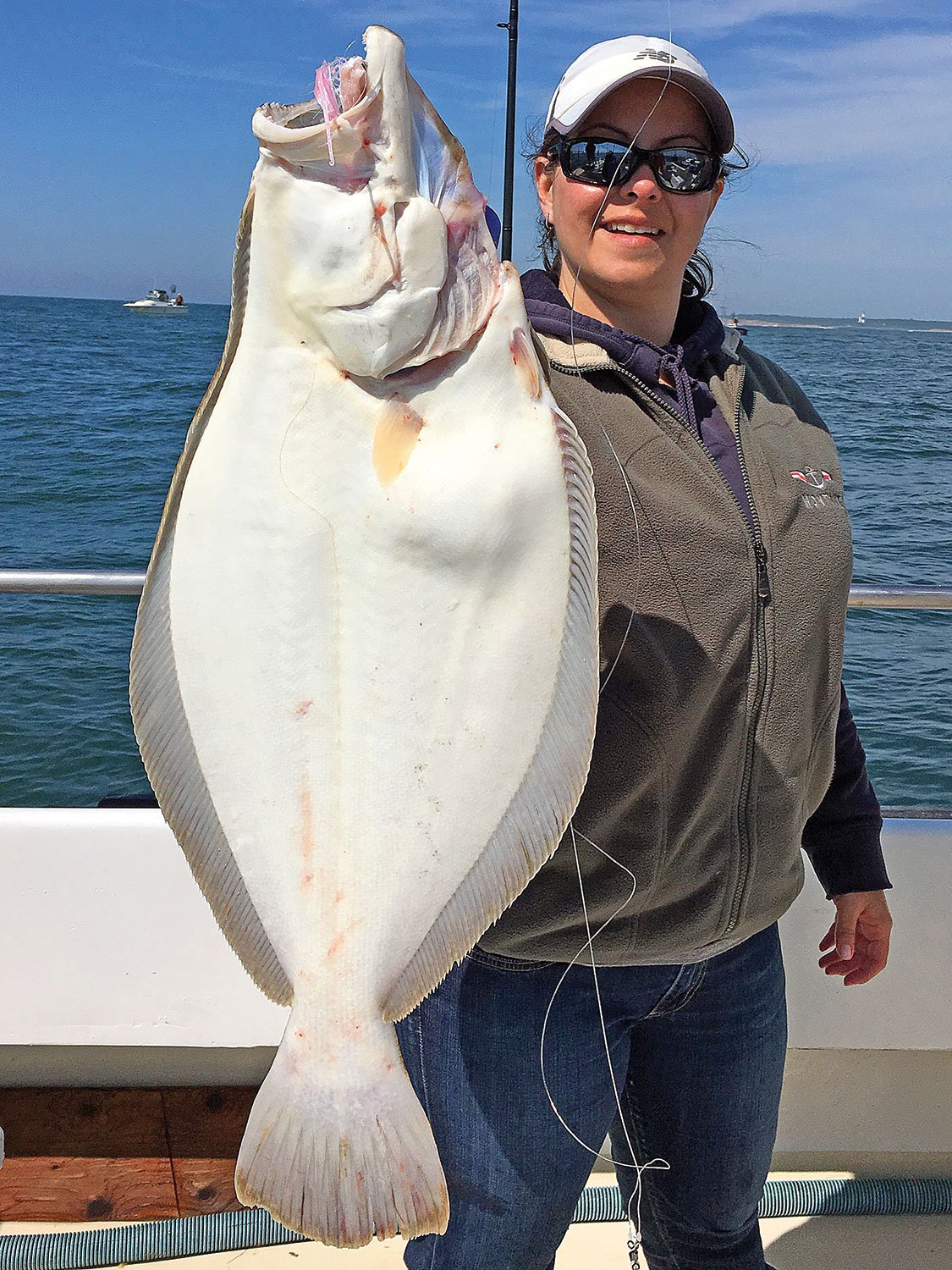
While reefs make great stomping grounds, they are certainly not the only option to nabbing big fluke. Break lines and drop-offs are often great places to find bait. These can occur at just about any depth but on average if you want to stay away from sea robins and skates, look to concentrate your efforts between 65 and 80 feet of water. Another option is fishing areas where the ocean bottom has been dredged out. These dredged holes that sit off the beach are dug deep exposing fossilized bottom from the Ice Age. At one time, this area of the ocean was actually marshland that over time sunk into the sea below rising ocean waters. These lairs look like moon craters, which provide countless depressions, and in turn draw in a food chain that oftentimes includes big fluke.
Generally speaking, a drift of 1 to 1-1/2 knots is ideal since this speed will keep the fluke aggressively chasing down your offerings while minimizing the activities of undesirables such as skates. A drift slower than a half knot often results in a burdensome pick of skates, which can make for a frustrating trip. One way to resolve that problem is by power drifting. Kicking the engine in and out of gear and keeping the boat at 1 to 1-1/2 knots will help ease the skate activity. A drift much over 2 knots may be too fast, which will require more weight to hold bottom and will result in a lot of short strikes, particularly in water deeper than 60 feet.
A sea anchor is the solution to slowing the drift down, which allows the rig to stay on the bottom and give the fluke a shot at the bait. Unless you are close to or directly in front of an inlet or breachway, an ocean drift is often influenced by the wind, more so than current. Always check wind and sea conditions, first for safety sake, but also for fishing conditions. Winds between 10 and 15 knots normally provide relatively calm seas and a steady enough drift to keep fluke coming over the rails.
Conventional and baitcasting outfits in the 15- to 20-pound class are best suited for this style of fishing. I recommend keeping spinning outfits to the shallower inshore depths since the thin sticks can be awkward in most deep water situations. Rods should be fast taper and capable of handling weights to 8 ounces. You will appreciate the backbone when it comes down to driving the hook home in 70 or 80 feet of water.
When it comes to filling the reel with line, braided synthetic is super sensitive at the tip of the rod, particularly when the bite is subtle. It allows for a better hook set and the ability to employ lighter weights and jigs, compliments of the thin diameter. The only drawback with braid is that it can be highly visible and since big fluke can be fussy at times, they may shy away from your rig. Smaller fluke have no qualms slamming baits attached to braid, but even there, I suggest attaching an 8-foot length of 20- to 25-pound fluorocarbon leader tied to the braid via an Albright knot. One word of caution with fluorocarbon; although the line nearly vanishes when it hits the water, it also lights up like a light bulb when there are nicks or scratches on it, which most definitely will have an impact on results. Fluorocarbon along the sandy fringes is fine, however, you may want to reconsider where rough bottom is an issue. Should that be the case, replace the fluorocarbon with a length of 25-pound test mono. Either way, frequently check the leader for abrasion and replace as needed.
Rig ‘em or Jig ‘em
Fluke rigs can be as complex or as simple as you wish to employ. Standard Plain Jane rigs are usually a safe bet as are hi/low rigs. However if you are into the bells and whistles, bucktails, ball jigs and teasers can be concocted several ways that will dupe big fluke. I like to fish a 2- to 4-ounce Spro Prime bucktail (depending on the speed of the drift) tied via an improved clinch knot at the end of the leader, then tie a dropper loop about 2 feet above the bucktail and slip on a teaser or just a plain super sharp Gamakatsu 5/0 Sea Hook. At times I will change the bucktail for a 2- to 4-ounce Tsunami ball jig or I’ll substitute the teaser or Sea Hook for a 3/8 ounce Spro Prime bucktail. As for bucktail colors, white, glow, pink and spearing blue are all fluke killers. As for baiting up, Berkley has made life easy with the 4- to 6-inch Gulp swimming mullet. In recent years, this bait has become popular and with good reason; they work. Apply them to the bucktails, ball jigs or a plain Sea Hook and watch them work. Fluke love them, especially new penny, nuclear chicken and glow colors. By the time you read this, Berkley will have released some new Gulp colors that have proven especially effective on big fluke during field tests, so you might want to check them out at your local tackle shop.
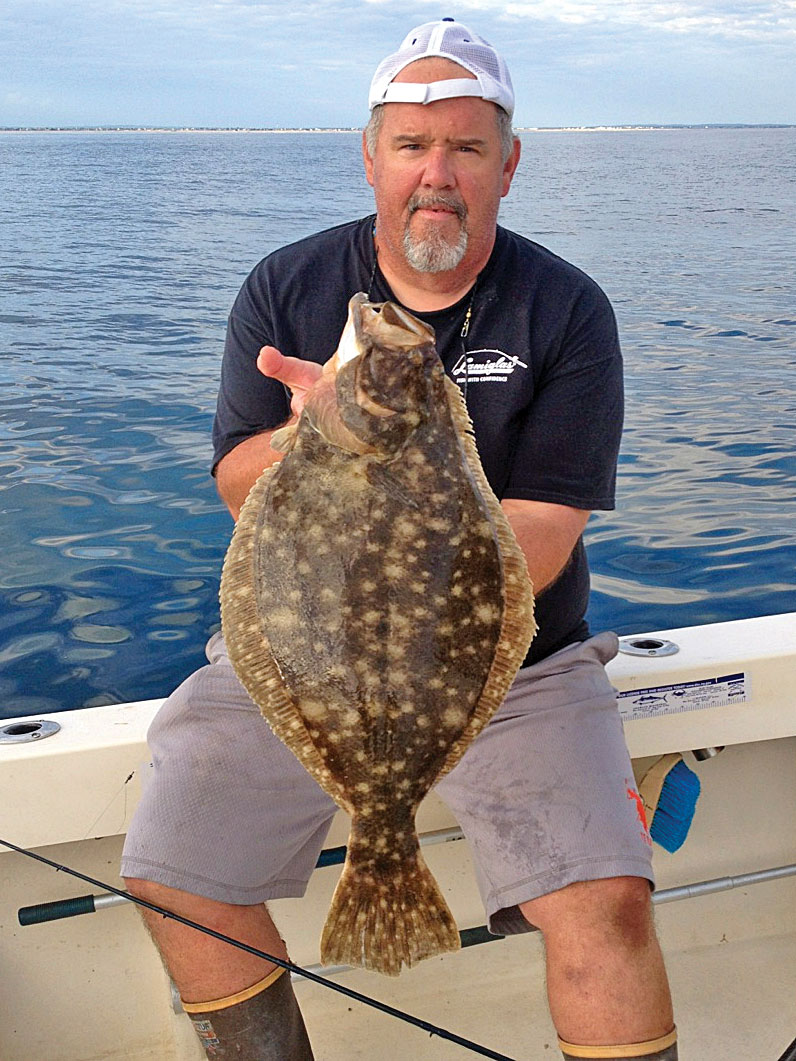
If you are adamant about using natural baits, 4- to 6-inch strips of squid, fluke belly, mackerel, and especially fresh sea robin strips will all catch the attention of big fluke. If available, you can add fresh bluefish belly strips to the menu as well. Standard spearing and sand eels are okay, but if at all possible, use the freshest strip baits available as these migrating doormats much prefer fresh red meat.
Patience is a Virtue
The key to nailing these bruisers is patience, especially given the fact that these fish are not as aggressive as their smaller siblings. In other words, never take the bait away from a fluke if you miss it on the first bite. The biggest mistake many anglers make is taking major league swings, and then reel up to see if any bait remains. This is a no-no. Instead, keep the bait down there for at least a minute or two. Big fluke will follow bait a long time before committing to it, so always give them a second chance.
Tides can be critical where big fluke are concerned. The first hour and last hour of either tide are often best during this time of the year. Then again it can be hard to predict what stage of tide will be best on any given day, given the conditions at the time. One thing is certain, when it comes to big fluke, the window of opportunity is short as they will chew well for a short duration and then shut down, and their smaller siblings will take over.
Lastly, once we get into September, it is important to pay close attention to the weather. Hurricanes passing offshore and more frequent low pressure systems can have a dramatic effect on inshore ocean waters. Getting to and from the fishing grounds can be especially dangerous, especially when running inlets or breachways where an offshore heave met by a strong outgoing current can create dangerous conditions. It’s no joke, pay attention to the weather and not just locally. Challenging a rough inlet is a battle that you could easily lose. It’s just not worth it, no matter how good the bite may be once you get outside.
Just about every fisherman I know who enjoys fluke fishing dreams of catching that fluke of a lifetime. Focusing your efforts in the ocean during August and September can make that dream a reality. And who knows, you may nail a contender for the 23-foot DV Miami Steiger Craft up for grabs in The Fisherman’s Dream Boat Challenge.
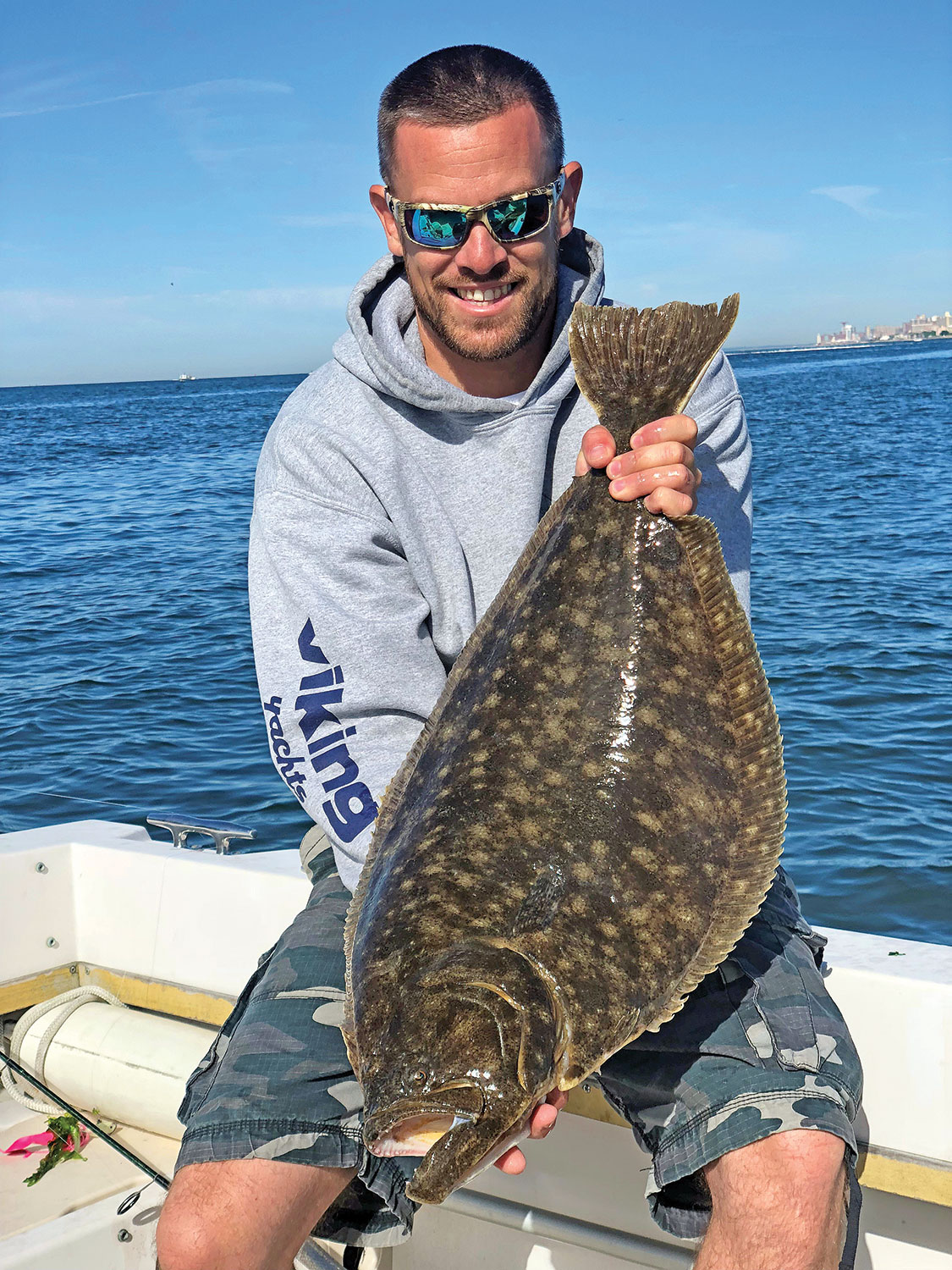
| TOP BAITS FOR BIG FLUKE |
|---|
|
If you are truly looking for that double-digit doormat, be sure to include some of these baits in your arsenal, and the fresher the better.
|


